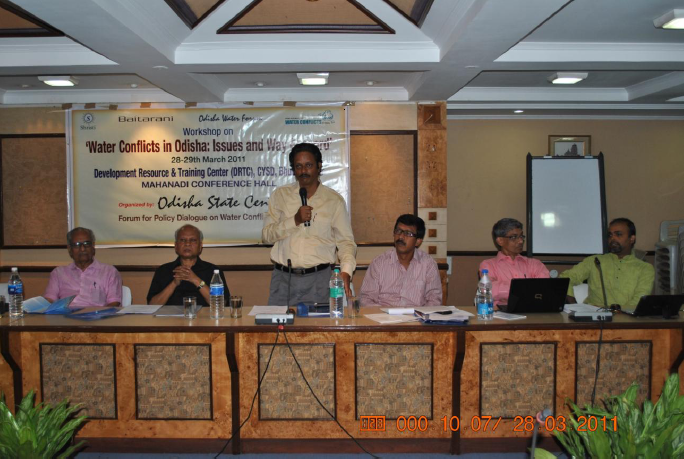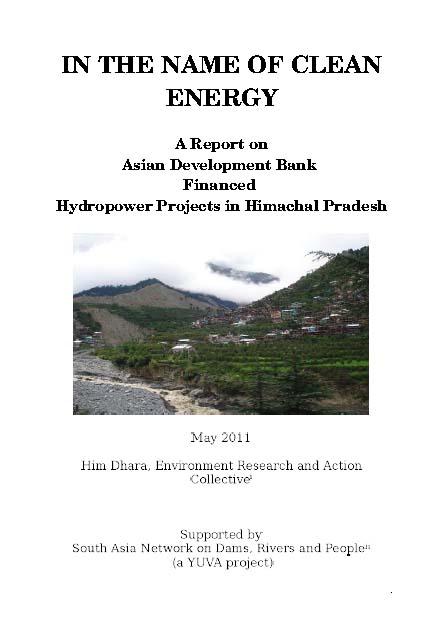/topics/hydropower
Hydropower
ADB funded hydro projects in Himachal Pradesh: Disastrous experience - Press release by Him Dhara, SANDRP and HLJM
Posted on 06 Jun, 2011 06:07 PMReport questions ADB funded projects under the 'Himachal Clean Energy Development Programme'.
- ADB loans for four hydroprojects at eco-fragile zones
- Livelihood concerns and environmental issues un-addressed
- Section 17/4 – Urgency clause being used by HPPCL for forced acquisition of land
- Poor EIA reports and non compliance to environmental norms
Recently, a Public Hearing for the World Bank funded Luhri Hydro Electric had to be cancelled after public protests making it clear that the environmental and social impacts of Hydropower projects as well as the increasing gap between their promise and performance, especially in the Himalayan region have become issues of serious concern. And yet these projects continue to be promoted in the garb of renewable and clean energy. So much so that governments are borrowing millions of rupees from international banks and financial institutions to fund these so called 'green' projects.The four ADB financed hydro power projects being constructed by HPPCL include the 195 MW Integrated Kashang Stage I, II and III and the 402 MW Shongtong-Karccham in Kinnaur. The other two projects are the 111 MW Sawara-Kuddu hydropower projects in Shimla district and the 100 MW Sainj hydropower project in Kullu District.
Proceedings of 'Water Conflicts in Odisha : Issues and way forward' - Organised by Odisha State Centre of the Forum for Policy Dialogue on Water Conflicts in India - 28th - 29th March 2011, Bhubaneswar
Posted on 27 May, 2011 12:48 PM
Development Resource & Training Centre (DRTC), CYSD, Bhubaneswar:
A 2-days Workshop on “Water conflicts in Odisha: Issues and way forward” has been organized during 28th – 29th, March, 2011 at Bhubaneswar by ‘Odisha State Centre’ of the ‘Forum for Policy Dialogue on Water Conflicts in India’. Environmental activists, thinkers, academicians, Government Officials, Farmer leader’s and Civil Society Organizations from different parts of the state participated in the workshop along with members of the National Steering Committee of Forum to discuss about the ongoing and emerging water conflicts in different geographies of the state.
In the name of clean energy – A report on Asian Development Bank financed hydropower projects in Himachal Pradesh
Posted on 25 May, 2011 07:06 PM This report by Him Dhara, an environmental research and action collective, deals with the Asian Development Bank financed hydropower projects in Himachal Pradesh, which are leading to obstruction of the rivers and their consequent disappearance for harnessing energy and making ‘judicious’ use of the water. Within the hydro sector the attention has turned to the Indian Himalayan region which is estimated to have seventy nine per cent of the total hydropower potential of the country.
This report by Him Dhara, an environmental research and action collective, deals with the Asian Development Bank financed hydropower projects in Himachal Pradesh, which are leading to obstruction of the rivers and their consequent disappearance for harnessing energy and making ‘judicious’ use of the water. Within the hydro sector the attention has turned to the Indian Himalayan region which is estimated to have seventy nine per cent of the total hydropower potential of the country.
The technology of ‘run of the river’ (ROR) used to tap “the flow of rivers” in high gradient zones to generate power has given impetus to setting up of hydro-projects in the Himalayan states. In India, the mountainous region of the Himalayas offered the “perfect setting” for such projects, with the availability of several flowing water sources that could be tapped before they reached the plains. Of the Himalayan states, after Arunachal Pradesh, Himachal Pradesh is second in line with a hydropower potential of about 21000 MW. The installed capacity has increased twenty fold (from 326 MW to 6370 MW) in the last ten years indicating the frenzied pace of hydropower development in the state.
Gujarat’s agricultural growth story: Reality check and important lessons for water management – A paper by Institute for Resource Analysis and Policy
Posted on 13 May, 2011 07:57 PMThe agricultural ‘growth’ seen in the recent past in Gujarat is nothing but a good recovery from a major dip in production occurred during the drought years of 1999 and 2000, because of four consecutive years of successful monsoon and bulk water transfer through the Sardar Sarovar project. The real ‘miracle growth’ in Gujarat’s agriculture appears to have occurred during the period from 1988 to 1998.
Future water solutions for India - a paper by Himanshu Thakkar in the Palgrave Development journal
Posted on 13 May, 2011 03:58 PMThis paper by Himanshu Thakkar published in the journal Development looks at the daunting challenges that future water demand places on India a
Energy from Water
Posted on 21 Apr, 2011 10:49 AM
An example technology is pico-hydro that uses local streams as a resource.
- The technology is transferred as an asset to households of farmers with access to streams, in the Western Ghats region.
- Most critically, the households decide the allocation of water between electricity generation and irrigation - they manage their demand for electricity based on water availability. The entire system retrofits into their current irrigation infrastructure.
- At the same time, there is an entire value chain of enterprises that develop the technology and deliver it to the farmer's doorstep, integrating access to MNRE subsidies and loans as necessary.
Development of training module for water safety plan in urban areas - A document by ESCI
Posted on 20 Apr, 2011 03:48 AMA Water Safety Plan (WSP) is an improved risk management tool designed to ensure the delivery of safe drinking water. It identifies hazards, means to control them, means and actions to identify loss of control and its restoration. It comprises system assessment and design, operational monitoring and management plans (including documentation and communication). Water quality guidelines have been issued by the WHO.
Let Pinder river flow free - Thousands gather in people's public hearing and vow to oppose the dam
Posted on 15 Apr, 2011 05:16 PMI pray to all my friends, brothers and sisters to not join the company in turning this valley into a monstrosity!” These are the powerful words by Narmada Devi from Village Padmallah that marked the flavor of a peoples' public hearing on the Devsari HEP.
This public hearing on the 3 April 2011 saw strength of 2000 people from all proposed Devsari HEP affected and surrounding villages of the Pinder valley. The hearing was organized by Bhu Swami Sangharsh Samiti and Matu Jan Sangathan and took place at the Sangam Maidan of Block Deval, Tehsil Tharali, District Chomoli, Uttarakhand. Public hearing at Deval was a peoples' response to the project proponent hearing at Chepdu on 20 January 2011.
Please reverse farcical decision of asking developers to do cumulative impact assessment in Sutlej Basin
Posted on 14 Apr, 2011 06:57 PMTo
Shri Jairam Ramesh
Union Minister of State (IC) of Environment and Forests,
New Delhi
Respected sir,
Agitation on World Anti-Dam Day - No dam on river Pinder - Update from Ganga - Matu People's Organization
Posted on 29 Mar, 2011 03:12 PM. On the occasion of the World Anti- Dam Day, on March 14, 2011 there was a large demonstration under the banner of Bhu- Swami Sangharsh Samiti and Matu Jansangathan in the three villages which served as venues for the drama of project ‘public hearings’. An effigy of the Land Acquisition Act was also burned by the people.





